
German collectors card in the series 'Vom Werden deutscher Filmkunst - Der Tonfilm', album no. 11, picture no. 43, group 44. Photo: Ufa / Ross Verlag. Leni Riefenstahl and Gustav Diessl in S.O.S. Eisberg/S.O.S. Iceberg (Arnold Fanck, 1933).

German collectors card by Ufa, Berlin, no. 1. Photo: Ufa. Sepp Rist in S.O.S. Eisberg/S.O.S. Iceberg (Arnold Fanck, 1933).

German collectors card by Ufa, Berlin, no. 2. Photo: Ufa. Scene from S.O.S. Eisberg/S.O.S. Iceberg (Arnold Fanck, 1933).

German collectors card by Ufa, Berlin, no. 3. Photo: Ufa. Leni Riefenstahl and crew at the set of S.O.S. Eisberg/S.O.S. Iceberg (Arnold Fanck, 1933).

German collectors card by Ufa, Berlin, no. 6. Photo: Ufa. Gustav Diessl in S.O.S. Eisberg/S.O.S. Iceberg (Arnold Fanck, 1933).
A request from Hollywood
At the beginning of 1932, German film director Arnold Fanck received a request from Hollywood to make a "nature feature film" for Universal Pictures. The film industry executives had in mind a project comparable to Fanck's mountain films Die weiße Hölle vom Piz Palü/The White Hell of Pitz Palu (Arnold Fanck, Georg Wilhelm Pabst, 1929) and Stürme über dem Montblanc/Storm over Mont Blanc (Arnold Fanck, 1930) since both had also been successfully shown in cinemas in the United States.
Fanck's first proposal to shoot on Mount McKinley in Alaska did not convince the Universal film bosses. A far more spectacular location had to be found, a setting that promised a cinematic enhancement of the theme of mountains, snow and ice that had already been introduced to filmgoers. In Fanck's circle of collaborators, Sepp Allgeier, Richard Angst and Bernhard Villinger, there had already been relevant experiences with Greenland and the Arctic Circle, respectively, since 1913 and 1926.
Fanck had already dealt with Greenland as a filming location earlier. For example, he wrote the manuscript for the film Milak, der Grönlandjäger/Milak, the Greenland Hunter (Georg Asagaroff, Bernhard Villinger, 1928). The Greenland expeditions of Umberto Nobile with the airship Italia in 1928 and of Alfred Wegener in 1930, which ended in drama, were present in the collective memory of the time so that the apron seemed prepared for a spectacular cinema film about Greenland.
Fanck transmitted his exposé expensively by telegram to Hollywood and travelled with his secretary and friend Elisabeth Kind on the Bremen to New York City in May 1932 and from there by rail across the North American continent to Los Angeles. There he was greeted by Paul Kohner and awaited by studio boss Carl Laemmle, who hosted a reception in his honour with Hollywood greats such as Marlene Dietrich and Greta Garbo. The cinematic venture was given a budget of 1 million Reichsmarks, the most expensive and elaborate project in film history up to that point.
Till 1948, Greenland was a territory closed to tourists or foreigners. Filming with actors, therefore, required the Danish authorities to circumvent this provision. Without further ado, the filming was declared a scientific expedition with the help of the ethnologist and polar explorer Knud Rasmussen, who also took over the patronage for the film. In addition, the glaciologists Fritz Loewe and Ernst Sorge were engaged, who had already made a name for themselves through their participation in Alfred Wegener's expeditions.
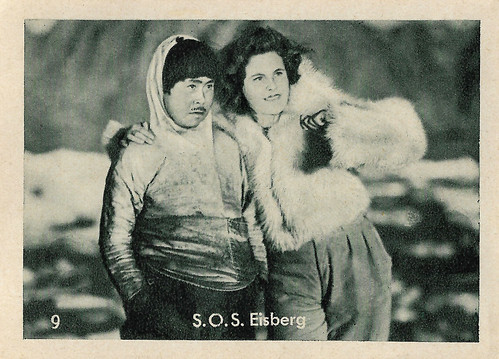
German collectors card by Ufa, Berlin, no. 9. Photo: Ufa. Leni Riefenstahl in S.O.S. Eisberg/S.O.S. Iceberg (Arnold Fanck, 1933).

German collectors card by Ufa, Berlin, no. 11. Photo: Ufa. Scene from S.O.S. Eisberg/S.O.S. Iceberg (Arnold Fanck, 1933).

German collectors card by Ufa, Berlin, no. 13. Photo: Ufa. Scene from S.O.S. Eisberg/S.O.S. Iceberg (Arnold Fanck, 1933).

German collectors card by Ufa, Berlin, no. 15. Photo: Ufa. Scene from S.O.S. Eisberg/S.O.S. Iceberg (Arnold Fanck, 1933).
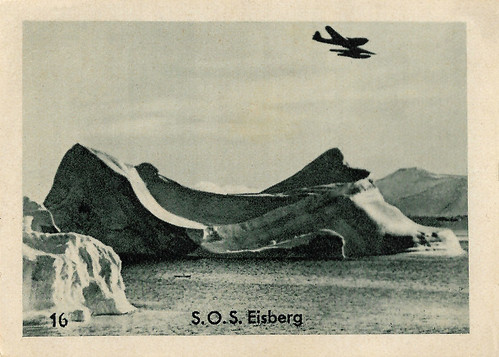
German collectors card by Ufa, Berlin, no. 16. Photo: Ufa. Scene from S.O.S. Eisberg/S.O.S. Iceberg (Arnold Fanck, 1933).
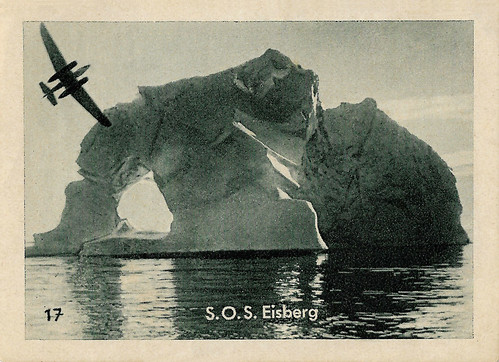
German collectors card by Ufa, Berlin, no. 17. Photo: Ufa. Scene from S.O.S. Eisberg/S.O.S. Iceberg (Arnold Fanck, 1933).
Riefenstahl, in her last film as an actress
Among the stars in S.O.S. Eisberg (Arnold Fanck, 1933) was Leni Riefenstahl, who had just made her directorial debut in Das blaue Licht/The Blue Light (Leni Riefenstahl, 1932). Riefenstahl, in her last film as an actress, co-starred with Gustav Diessl and Ernst Udet in the German version S.O.S. Eisberg, and with Gibson Gowland and Rod La Rocque in the English version, S.O.S. Iceberg. Ernst Udet, a former German ace in the First World War, in a cameo performance, flew in both versions.
S.O.S. Eisberg follows the account of the real-life Alfred Lothar Wegener polar expedition of 1929-1930. In April-October 1929, Wegener embarked on his third expedition to Greenland, which laid the groundwork for the main expedition that he was planning to lead in 1930-1931. Wegener's last Greenland expedition was in 1930.
The 14 participants under his leadership were to establish three permanent stations from which the thickness of the Greenland ice sheet could be measured and year-round Arctic weather observations made. They would travel on the ice cap using two innovative, propeller-driven snowmobiles, in addition to ponies and dog sledges. Wegener felt personally responsible for the expedition's success, as the German government had contributed $120,000 ($1.5 million in 2007 dollars).
Success depended on enough provisions being transferred from West camp to Eismitte ("mid-ice") for two men to winter there, and this was a factor in the decision that led to his death. Owing to a late thaw, the expedition was six weeks behind schedule and, as summer ended, the men at Eismitte sent a message that they had insufficient fuel and so would return on 20 October. On 24 September, although the route markers were by now largely buried under snow, Wegener set out with thirteen Greenlanders and his meteorologist Fritz Loewe to supply the camp by dog sledge. During the journey, the temperature reached −60 °C (−76 °F) and Loewe's toes became so frostbitten they had to be amputated with a penknife without anaesthetic.
Twelve of the Greenlanders returned to West camp. On 19 October the remaining three members of the expedition reached Eismitte. Expedition member Johannes Georgi estimated that there were only enough supplies for three at Eismitte, so Wegener and Rasmus Villumsen took two dog sledges and made them for West camp. They took no food for the dogs and killed them one by one to feed the rest until they could run only one sledge. While Villumsen rode the sledge, Wegener had to use skis, but they never reached the camp: Wegener died and Villumsen was never seen again. After Wegener was declared missing in May 1931, and his body found shortly thereafter, Kurt Wegener took over the expedition's leadership in July, according to the prearranged plan for such an eventuality.
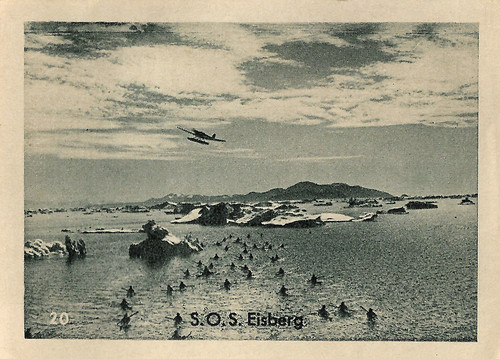
German collectors card by Ufa, Berlin, no. 20. Photo: Ufa. Scene from S.O.S. Eisberg/S.O.S. Iceberg (Arnold Fanck, 1933).
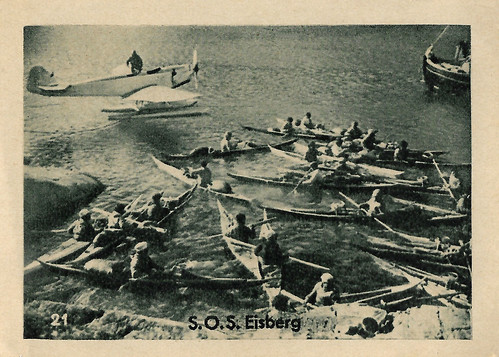
German collectors card by Ufa, Berlin, no. 21. Photo: Ufa. Scene from S.O.S. Eisberg/S.O.S. Iceberg (Arnold Fanck, 1933).
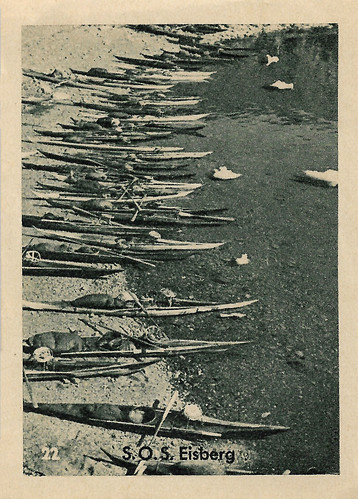
German collectors card by Ufa, Berlin, no. 22. Photo: Ufa. Publicity still for S.O.S. Eisberg/S.O.S. Iceberg (Arnold Fanck, 1933).

German collectors card by Ufa, Berlin, no. 24 of 24. Photo: Ufa. Leni Riefenstahl in S.O.S. Eisberg/S.O.S. Iceberg (Arnold Fanck, 1933).
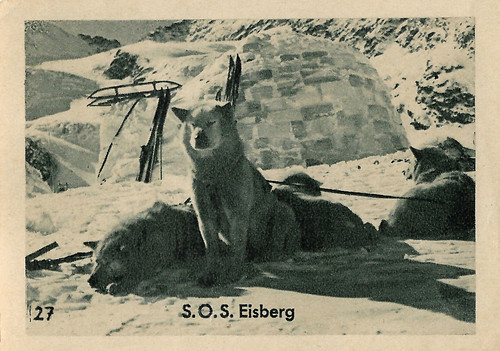
German collectors card by Ufa, Berlin, no. 27. Photo: Ufa. Publicity still for S.O.S. Eisberg/S.O.S. Iceberg (Arnold Fanck, 1933).

German collectors card by Ufa, Berlin, no. 28. Photo: Ufa. Publicity still for S.O.S. Eisberg/S.O.S. Iceberg (Arnold Fanck, 1933).

German collectors card by Ufa, Berlin, no. 29. Photo: Ufa. Publicity still for S.O.S. Eisberg/S.O.S. Iceberg (Arnold Fanck, 1933).
Brand begins sending out an S.O.S. on his wireless
This expedition inspired the Greenland expedition episode of Adam Melfort in John Buchan's novel 'A Prince of the Captivity' (1944) and the film S.O.S. Eisberg/S.O.S. Iceberg (Arnold Fanck, 1933). At a banquet at the International Society for Arctic Research, he members toast scientist Dr. Carl Lorenz (Gustav Diessl), who is about to recreate famed explorer Wegener's ill-fated expedition. Lawrence's team consists of two scientists, Dr. Johannes Brand (Sepp Rist) and Dr. Jan Matushek (Max Holzboer), his friend, Fritz Kuemmel (Walter Riml), their financial backer, John Dragan (Walter Riml), and their pilot to the Arctic, Lorenz's wife Hella (Leni Riefenstahl).
After Hella drops them at their base camp, the men begin their long trek to recover Wegener's records and prove his theories on ice floes. As the weeks pass, Brand and the others fear they will not survive when the ice breaks up, but Lorenz scoffs and refuses to wait until winter. Early one morning, Lorenz sets out on his own. His companions fear he is lost.
They find a hut Wegener occupied and a note from Lorenz saying that he is trying to reach a native village. Suddenly, the break up of the ice leaves their sledges of food supplies tumbling into a ravine. The rescuers take refuge on a huge iceberg where they discover that Lorenz is there, dazed and uncommunicative. Brand begins sending out an S.O.S. on his wireless and Hella immediately leaves to search for her husband. Disaster strikes, with Dragan going mad, and as Kümmel fights with him to prevent their dog, Nakinak, from being killed, Kümmel falls to his death.
When Hella finds the survivors, she misjudges her landing and crashes but is able to swim to the iceberg. Brand seeing they are drifting out to sea, dives into the water, and is picked up by another pilot (Ernst Udet) following Hella's flight path. The pilot flies Brand to the nearby Inuit village. Matushek sees two polar bears fighting over a seal but is killed when he tries to spear the bears.
Dragan then attacks Hella, but by then her husband has come to his senses, and she is saved. The iceberg begins to come apart, throwing Dragan into the sea. Lorenz, Hella and Nakinak are rescued by the Inuit. The three survivors later are aboard a ship bound for home, but Lorenz is haunted by the deaths incurred in his misguided expedition.

German collectors card by Ufa, Berlin, no. 30. Photo: Ufa. Publicity still for S.O.S. Eisberg/S.O.S. Iceberg (Arnold Fanck, 1933).
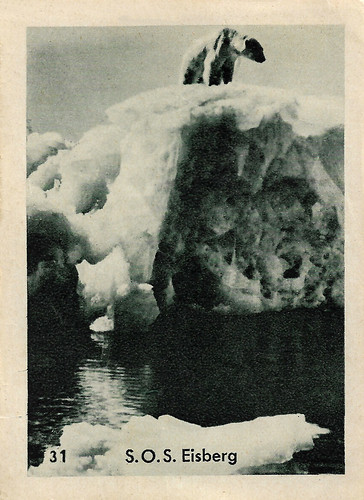
German collectors card by Ufa, Berlin, no. 31. Photo: Ufa. Publicity still for S.O.S. Eisberg/S.O.S. Iceberg (Arnold Fanck, 1933).

German collectors card by Ufa, Berlin, no. 32. Photo: Ufa. Publicity still for S.O.S. Eisberg/S.O.S. Iceberg (Arnold Fanck, 1933).
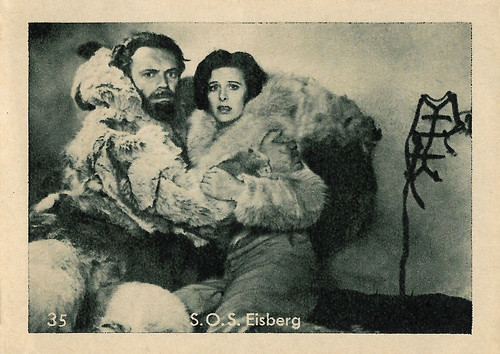
German collectors card by Ufa, Berlin, no. 35. Photo: Ufa. Gustav Diessl and Leni Riefenstahl in S.O.S. Eisberg/S.O.S. Iceberg (Arnold Fanck, 1933).

German collectors card by Ufa, Berlin, no. 36. Photo: Ufa. Gustav Diessl and Leni Riefenstahl at right in S.O.S. Eisberg/S.O.S. Iceberg (Arnold Fanck, 1933).

German collectors card by Ufa, Berlin, no. 38. Photo: UfA. Sepp Rist in S.O.S. Eisberg/S.O.S. Iceberg (Arnold Fanck, 1933).
Sources: Wikipedia (German and English) and IMDb.
No comments:
Post a Comment